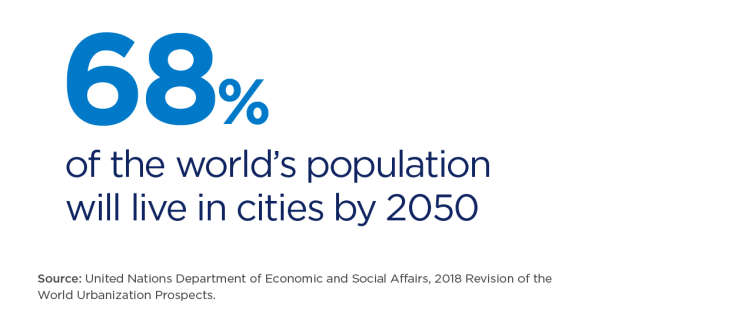
By Mar Soro, Group Head of Sustainability Advocacy at Bupa
The health impacts of climate change are already being felt, especially in cities. Rising global temperatures mean a staggering 1.6 billion people will be living in extreme heat by 2050, while 41% of cities are already experiencing pollution levels that are over seven times higher than the World Health Organization’s air quality guidelines.
There is a disproportionate impact on people living in urban areas, especially those with pre-existing health conditions, and the pressures on health systems, in addition to the sectors’ emissions, will be further exacerbated. So what do increased temperatures and air pollution mean for urban health and how we deliver care? And what can we do about this?
How are urban environments, health and climate change connected?
Climate change is the biggest threat to global health, and people who live in cities are especially vulnerable to rising temperatures and air pollution. The lack of green spaces to provide shade, and the amount of heat-absorbing buildings, roads and traffic, mean cities are already warmer than rural areas.
Cities are home to over half of the world’s population and the United Nations predicts that an extra 2.5 billion people will live in urban areas by 2025. Research from C40 Cities shows that if no action is taken to address the impact of climate change in cities, over 1.6 billion residents in 970 cities will face extreme heat by 2050.

Extreme heat can lead to issues like hyperthermia and heat stroke, and make existing heart, lung or kidney diseases worse. Air pollutants from burning fossil fuels are also problematic for people with cardiovascular and respiratory diseases.
Exposure to continued high temperatures can lead to an increase in mental health conditions like stress, anxiety and cognitive impairment. The physical discomfort of heat alone can cause psychological distress, which is often worsened when people’s sleep is interrupted by high temperatures.

These health impacts will increasingly put additional strain on health systems that are already facing significant pressures, and current models of care will need to evolve to meet these changing demands, with a greater emphasis on preventing ill health and improving resilience of our healthcare systems.
What can we do about it?
There is a growing recognition that helping people stay healthy in a changing climate requires a new health-centred approach to urban design (and redesign), while also reimagining how we deliver care to reduce its impact on the environment. If we get this right, it could benefit billions of people. And while this is a huge challenge, it’s also a huge opportunity.
By taking action now, urban planning can both address the impacts of climate change and improve people’s health. Increasing green spaces, for example, not only cools cities down by creating more shade, but also boosts mental health and can encourage more people to adopt active, healthier lifestyles and help prevent disease in the first place. This preventative approach, alongside steps that promote early identification of disease and early interventions, could not only significantly improve health outcomes, but also reduce the burden on healthcare systems and lower the carbon emissions associated with treatment.
Some cities are already leading the way in tackling climate change by shifting demand to clean energy, retrofitting buildings, encouraging active and public transport modes, and bringing health closer to communities and homes through personalised and preventative digital solutions.

How can we work in collaboration?
Accelerating the transformation to resilient and healthy cities globally, supported by net zero health systems, cannot be done in isolation. It requires cross-sector partnerships, collaboration and sharing ideas. That’s why we’ve been learning from and joining forces with others, such as the Norman Foster Foundation, C40 Cities and the Sustainable Markets Initiative, to help supercharge progress.
We’re also looking at how we can encourage people to adopt healthy lifestyles through our Healthy Cities programme. As part of this, we work with local governments, NGOs and environmental experts around the world to restore and regenerate green spaces.
With governments, healthcare professionals, city officials, urban planners, engineers, businesses and local communities working hand-in-hand, we have a real opportunity to truly maximise the health benefits of climate action in our cities, and support the resilience of our health systems.




